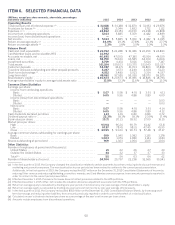American Express 2015 Annual Report Download - page 55
Download and view the complete annual report
Please find page 55 of the 2015 American Express annual report below. You can navigate through the pages in the report by either clicking on the pages listed below, or by using the keyword search tool below to find specific information within the annual report.
We may not be able to effectively manage credit risk related to consumer debt, business loans, settlement
with GNS partners, merchant and consumer bankruptcies, delinquencies and other credit trends that can
affect spending on card products, debt payments by individual and corporate customers and businesses that
accept our card products, which could have a material adverse effect on our results of operations and financial
condition.
We are exposed to both individual credit risk, principally from consumer and small business Card Member
receivables and loans, and institutional credit risk from merchants, GNS partners, GCS clients, Plenti partners and
treasury and investment counterparties. Third parties may default on their obligations to us due to bankruptcy, lack of
liquidity, operational failure or other reasons. Country, regional and political risks can contribute to credit risk. Our
ability to assess creditworthiness may be impaired if the criteria or models we use to manage our credit risk become
less predictive of future losses, which could cause our losses to rise and have a negative impact on our results of
operations. Rising delinquencies and rising rates of bankruptcy are often precursors of future write-offs and may
require us to increase our reserve for loan losses. After write-off and delinquency rates reached historical lows, they
have recently leveled out and begun to increase in line with our expectations. Higher write-off rates and an increase in
our reserve for loan losses adversely affect our profitability and the performance of our securitizations, and may
increase our cost of funds. In addition, our ability to recover amounts that we have previously written off may be
limited, which could have a negative impact on our revenues.
Although we make estimates to provide for credit losses in our outstanding portfolio of loans and receivables,
these estimates may not be accurate. In addition, the information we use in managing our credit risk may be
inaccurate or incomplete. Although we regularly review our credit exposure to specific clients and counterparties and
to specific industries, countries and regions that we believe may present credit concerns, default risk may arise from
events or circumstances that are difficult to foresee or detect, such as fraud. We may also fail to receive full
information with respect to the credit risks of our customers. In addition, our ability to manage credit risk may be
adversely affected by legal or regulatory changes (such as bankruptcy laws and minimum payment regulations).
Increased credit risk, whether resulting from underestimating the credit losses inherent in our portfolio of loans and
receivables, deteriorating economic conditions, changes in our mix of business or otherwise, could require us to
increase our provision for losses and could have a material adverse effect on our results of operations and financial
condition.
Adverse financial market conditions may significantly affect our ability to meet liquidity needs, access to
capital and cost of capital.
We need liquidity to pay merchants, operating and other expenses, interest on debt and dividends on capital stock
and to repay maturing liabilities. If we are unsuccessful in managing our liquidity risk, we may maintain too much
liquidity, which can be costly and limit financial flexibility; or we may be too illiquid, which could limit our investments in
growth opportunities, curtail operations or result in financial distress during a liquidity event.
The principal sources of our liquidity are payments from Card Members and merchants, cash flow from our
investment portfolio and assets, consisting mainly of cash or assets that are readily convertible into cash, direct and
third-party sourced deposits, debt instruments such as unsecured medium- and long-term notes and asset
securitizations, securitized borrowings through our secured financing facilities, the Federal Reserve discount window
and long-term committed bank borrowing facilities.
Our ability to obtain financing in the debt capital markets for unsecured term debt and asset securitizations is
dependent on investor demand. Disruptions, uncertainty or volatility across the financial markets could negatively
impact market liquidity and limit our access to capital required to operate our business. Such market conditions may
limit our ability to replace, in a timely manner, maturing liabilities, satisfy regulatory capital requirements and access
the capital necessary to grow our business. As such, we may be forced to delay raising capital or bear an unattractive
cost to raise capital, which could decrease profitability and significantly reduce financial flexibility. Market disruption
and volatility could have an adverse effect, which may be material, on our ability to access capital and on our business,
financial condition and results of operations.
For a further discussion of our liquidity and funding needs, see “Consolidated Capital Resources and Liquidity —
Funding Programs and Activities” under “MD&A.”
Any reduction in our and our subsidiaries’ credit ratings could increase the cost of our funding from, and
restrict our access to, the capital markets and have a material adverse effect on our results of operations and
financial condition.
Rating agencies regularly evaluate us and our subsidiaries, and their ratings of our and our subsidiaries’ long-term
and short-term debt are based on a number of factors, including financial strength as well as factors not within our
control, including conditions affecting the financial services industry generally, and the wider state of the economy.
Our and our subsidiaries’ ratings could be downgraded at any time and without any notice by any of the rating
agencies, which could, among other things, adversely limit our access to the capital markets and adversely affect the
cost and other terms upon which we and our subsidiaries are able to obtain funding.
44
























